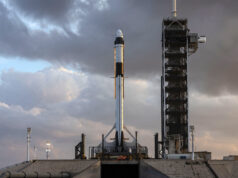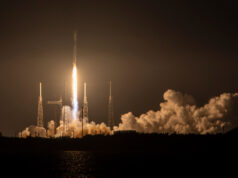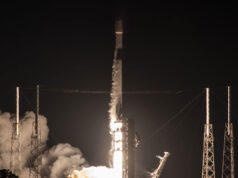
Under the cloak of the Florida night sky, another powerful roar echoed across Cape Canaveral. At precisely 10:09 p.m. Eastern Time on Sunday, April 27, 2025, a SpaceX Falcon 9 rocket clawed its way into orbit, carrying its vital cargo: a fresh batch of Starlink satellites destined for low-Earth orbit. This wasn’t just another launch; it marked a significant moment, the 250th dedicated Starlink mission launched by SpaceX, pushing the boundaries of global internet connectivity further than ever before.
The launch originated from Space Launch Complex 40 (SLC-40) at Cape Canaveral Space Force Station. For those watching, it was a familiar, yet still awe-inspiring sight – the bright column of fire against the dark sky, the rumble felt miles away. On board this mission, designated Starlink 12-23, were 23 Starlink satellites. Among them were 13 satellites equipped with the new “Direct to Cell” technology, a capability set to truly change the game in mobile communication.
The workhorse of this mission was Falcon 9 booster B1077. This specific rocket stage has seen incredible service, completing its 20th flight. Think about that for a moment – twenty times this booster has powered a rocket off the planet, endured the violent forces of ascent, separated from the upper stage, flipped around, and guided itself back through the atmosphere for a controlled landing. Just over eight minutes after liftoff, B1077 touched down gently on the droneship “Just Read the Instructions,” stationed hundreds of miles out in the Atlantic Ocean.
This successful landing wasn’t just a neat trick; it’s the cornerstone of SpaceX’s approach to making space access more affordable and frequent. Reusing these complex machines again and again drives down the cost per launch, enabling the rapid deployment needed to build out the vast Starlink constellation. Each landing feels routine now, but it represents a monumental engineering achievement that was once considered science fiction. The sight of a rocket stage descending from space, engines firing for a final braking burn before a perfect touchdown, remains a powerful testament to human ingenuity and perseverance.
But what are these satellites doing up there, and why does SpaceX launch so many, so often? The answer lies in the ambitious goal of Starlink: to provide high-speed, low-latency internet access to virtually every corner of the globe. Traditional satellite internet often comes from satellites in much higher orbits, leading to significant delays in communication. Starlink satellites operate much closer to Earth, in low-Earth orbit (LEO), drastically reducing that delay and making activities like video calls, online gaming, and streaming far more responsive.
The satellites launched on this mission, like those before them, will join a growing network thousands strong. Each satellite acts as a node in this vast space-based network, beaming internet signals down to user terminals on the ground. This is particularly impactful for people living in rural areas, remote communities, or places where traditional internet infrastructure is unreliable or simply doesn’t exist. For many, Starlink is not just an alternative; it’s their first real connection to the digital world, opening doors to education, commerce, healthcare, and communication that were previously closed.
The inclusion of 13 satellites with Direct to Cell capability on this launch marks an exciting step forward. This technology aims to allow standard smartphones, without any special equipment, to connect directly to Starlink satellites. While the initial service might support text messages, the long-term vision is to enable voice calls and data connectivity, even in the most isolated locations. Imagine being able to send a message or make a call from a remote hiking trail, a boat far out at sea, or a disaster area where ground networks are down. This capability holds immense potential for emergency services, outdoor enthusiasts, and anyone who needs reliable communication beyond the reach of traditional cell towers.
Reaching the 250th dedicated Starlink mission milestone is a stark reminder of the sheer scale and pace of this undertaking. Since the first dedicated Starlink launch in May 2019, SpaceX has been relentlessly building this constellation, launch after launch, week after week. As of this latest mission, satellite trackers estimate SpaceX has launched well over 8,000 Starlink satellites in total, though not all of those remain operational or in their final orbits. This rapid deployment schedule is critical to building a robust, global network that can handle increasing user demand and provide continuous coverage.
The development and deployment of a constellation of this size are not without challenges. Concerns from the astronomical community regarding the brightness of the satellites and their potential impact on observations are ongoing, and SpaceX has been working on mitigation efforts, including darkening satellite surfaces and launching satellites equipped with visors. Managing the increasing number of objects in low-Earth orbit to prevent collisions and minimize space debris is also a critical consideration for all satellite operators.
Despite these challenges, the impact of Starlink is undeniable. Reports from users in various parts of the world highlight how the service has transformed their access to information and opportunity. Farmers in remote regions gaining access to market data, students in underserved areas participating in online learning, families staying connected across vast distances – these are the human stories behind the numbers and the launches.
The successful launch of Starlink 12-23, adding more satellites and expanding the Direct to Cell capability, is another step in this ambitious endeavor. It underscores the persistent effort by teams at SpaceX, from the engineers designing the satellites and rockets to the crews on the ground preparing for launch and recovering boosters at sea. Each fiery ascent from Florida or California represents countless hours of work and a shared vision of a more connected world. As the constellation grows, that vision inches closer to reality, promising to bring the internet to more people in more places than ever before.










